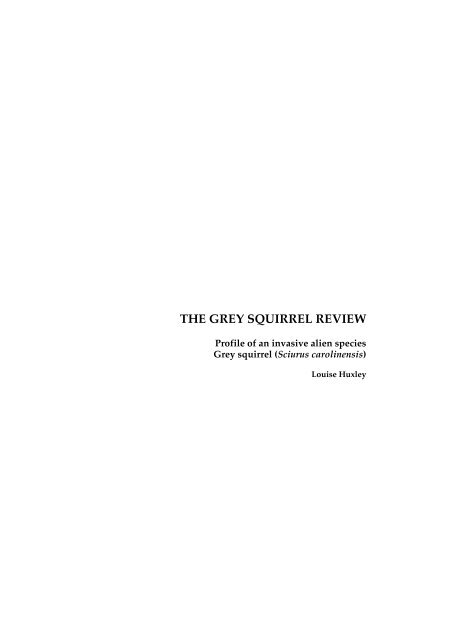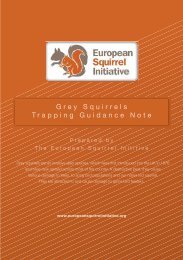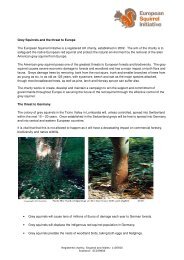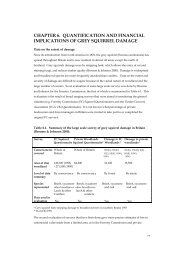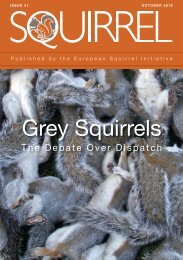foreword & introduction (375 kb) - European Squirrel Initiative
foreword & introduction (375 kb) - European Squirrel Initiative
foreword & introduction (375 kb) - European Squirrel Initiative
You also want an ePaper? Increase the reach of your titles
YUMPU automatically turns print PDFs into web optimized ePapers that Google loves.
THE GREY SQUIRREL REVIEW<br />
Profile of an invasive alien species<br />
Grey squirrel (Sciurus carolinensis)<br />
Louise Huxley
First published in 2003 by <strong>European</strong> <strong>Squirrel</strong> <strong>Initiative</strong>, with additional<br />
support from Woodland Heritage, PO Box 168, Haslemere, GU27 1XQ.<br />
All rights reserved. No part of this publication may be reproduced, or stored<br />
in a retrieval system or transmitted in any form or by any means, electronic,<br />
electrostatic, magnetic tape, mechanical, photocopying, recording or<br />
otherwise, without prior permission in writing from ESI.<br />
Citation: Huxley, L. 2003. The Grey <strong>Squirrel</strong> Review. Profile of an invasive<br />
alien species. Grey squirrel (Sciurus carolinensis). ESI Dorset.<br />
Front cover: A Baxter (reproduced courtesy of Forest Research)
CONTENTS<br />
FOREWARD ……………………………………………………………………….<br />
INTRODUCTION ………………………………………………………………… 1<br />
1 SQUIRREL ECOLOGY<br />
Grey squirrel (Sciurus carolinensis) ecology …………………………………….. 3<br />
Energy requirements …………………………………………………………….. 6<br />
Red squirrel (Sciurus vulgaris L) ecology ………………………………………... 8<br />
Genetic variation …………………………………………………………………. 8<br />
Behaviour …………………………………………………………………………. 10<br />
Forest Design Plans ……………………………………………………………… 12<br />
2 SQUIRREL POPULATION TRENDS …………………………………….. 16<br />
Italy ……………………………………………………………………………….. 17<br />
Ireland …………………………………………………………………………… 21<br />
Britain ……………………………………………………………………………. 23<br />
Densities ………………………………………………………………… 26<br />
Spread of grey squirrel ………………………………………………… 27<br />
3 FATE OF THE RED SQUIRREL<br />
Ecological competition and replacement ……...…..……………………………... 31<br />
Competitive exclusion …………………………………………………………. 31<br />
Woodland fragmentation ………………………………………………………. 32<br />
Co-habitation? …………………………………………………………………… 33<br />
Disease ……………………………………………………………………………… 36<br />
4 ENVIRONMENTAL & ECONOMIC DAMAGE BY THE ALIEN GREY<br />
SQUIRREL<br />
Tree damage ……………………………………………………………………… 43<br />
<strong>Squirrel</strong> damage to young trees ………………………………………………... 47<br />
Measuring damage scales ………………………………………………………. 50<br />
The effect of squirrel damage on timber value ………………………………. 56<br />
Other effects of squirrel damage ……………………………………………… . 57<br />
5 CONTROL METHODS<br />
Predicting damage ……………………………………………………………………. 59<br />
Bark-stripping and woodland design ………………………………………… . 63<br />
Damage control ……………………………………………………………………… . 64<br />
The effectiveness of squirrel control………... …………………………………71<br />
Costs of bark-stripping and squirrel control …………………………………. 74<br />
Density of hoppers ……………………………………………………………… 75<br />
6 QUANTIFICATION AND FINANCIAL IMPLICATIONS OF GREY<br />
SQUIRREL DAMAGE<br />
Data on the extent of damage………………………………………………… 77<br />
Estimates of the costs of grey squirrel damage ……………………………… 78<br />
Bark stripping …………………………………………………………. 80<br />
Value of crops at risk …………………………………………………. 81<br />
Estimates of the costs of grey squirrel control ……………………………… 82<br />
Inidvidual examples ………………………………………………….. 82<br />
Forestry Commission statistics ………………………………………………… 85<br />
The National Forest ………………………………………………………… ….. 90
ACKNOWLEDGEMENTS<br />
The author is particularly grateful to those who have assisted her in the<br />
production of this review:<br />
Charles Huxley, Dorset<br />
Dr Peter Savill, Dept of Plant Sciences, University of Oxford<br />
Charles Dutton, Silvanus Services, Dorset<br />
Chris Inglis, FTA<br />
Brenda Mayle, Forest Research<br />
Prof David Patton, Arizona<br />
Prof Julian Evans, Hampshire<br />
Corrie Bruemmer, English Nature<br />
Paul Raymond Barker, Powys<br />
Michael Sayer, CLA<br />
Dr Eugene Hendrik, COFORD, Ireland<br />
Ian Jack, Cumbria<br />
Edward Brun, Norfolk<br />
Miles Barne, Suffolk<br />
Peter Goodwin, Suffolk<br />
Bede Howell, Worcestershire<br />
Huw Denman, Carmarthenshire<br />
Andy Wiseman, Buccleugh Estates<br />
Hugh Williams, National Forest Company<br />
Graham Taylor, Herefordshire<br />
Dr Robert Kenward, Dorset<br />
Dr Peter Lurz, University of Newcastle<br />
Dr Steve Rushton, University of Newcastle<br />
Peter Naylor, Cumbria<br />
Dr Piero Genovesi, National Wildlife Institute, Bologna, Italy<br />
Dr D Viner, UEA<br />
Mark Ferryman, Forest Research<br />
Archie Miles
FOREWARD<br />
The menace of grey squirrels is worsening. Although only introduced in Victorian<br />
times, they have spread throughout much of Britain displacing the native red squirrel<br />
and causing often irreparable damage to broadleaved trees like beech, oak and<br />
sycamore.<br />
In this book Louise Huxley has assembled all that is known about grey squirrels and<br />
attempted dispassionately to evaluate the threat that they represent. She concludes that<br />
they threaten the future of successfully growing broadleaved woodlands for anything<br />
other than amenity. Grey squirrels may kill trees, degrade timber quality, raid birds’<br />
nests and harm other wildlife. And, they have few predators to control their numbers.<br />
In summary, they have found, like the coypu did in the Norfolk Broads, a habitat so<br />
congenial and so available that they are over-running it. The damage they cause is<br />
making many people now wish that the grey squirrel could share, too, for the sake of<br />
our woodlands, the coypu’s fate. If elimination is unattainable, the grey squirrel must<br />
at least be controlled effectively where it matters so that its harm can be curtailed.<br />
I write these remarks as an owner of a small broadleaved woodland and as a scientist.<br />
It is to the latter community of forest scientists and wildlife ecologists that my<br />
comments here are first addressed since they hold the key to successful control. The<br />
success of warfarin-based control since the mid 1970s shows what sound research can<br />
accomplish, and the promise of immuno-contraception demonstrates that new<br />
approaches are feasible albeit if not adequately deliverable at the moment. But both<br />
these control strategies are or are about to be discontinued, and what is offered in their<br />
place? Nothing, only trapping and the daily expense that requires.<br />
This matter of expense has another side. This book attempts for the first time to<br />
estimate what grey squirrel damage is really costing. From whatever way one looks at<br />
it, the figure comes to several million pounds per year! The worry is not only the scale<br />
but how it detracts from all that the Forestry Commission and other public bodies are<br />
trying to achieve through funding woodland initiatives which themselves only amount<br />
to around £30-40 million per year. Added to this is that much of the grant aid supports<br />
new woodlands of native broadleaved species. This is greatly welcomed by most<br />
people, but they are the very woods the success of which grey squirrels will undo.<br />
The appeal for renewed effort to control this pest is heightened by the worrying<br />
spread of grey squirrels in northern Italy and the inevitability of further spread into the<br />
great beech and oak forests of France, Germany and elsewhere in Europe. There is a<br />
political imperative to address the problem. Mrs Huxley’s book presents the facts, the<br />
onus is now on the state, private sector and scientific community to tackle this menace<br />
to ensure the health and well-being of the woodlands that grace our countryside.<br />
Professor Julian Evans OBE
INTRODUCTION<br />
The protection of woodland in Europe, and especially in Britain, against the<br />
ravages of the grey squirrel is far more serious than most will appreciate. The<br />
introduced alien American grey squirrel (Sciurus carolinensis) is fast assuming<br />
the role and occupying the habitat of the native, red squirrel (Sciurus vulgaris<br />
L.) Europe wide. This review seeks to dovetail all material that has been<br />
produced on the species and provide a comprehensive study of its ecological<br />
profile, its impact on the red squirrel, and the causal mechanisms that may<br />
result in widespread devastation of <strong>European</strong> woodlands.<br />
Since the North American grey squirrel was introduced to Britain in the late<br />
19 th century it has become a serious pest, first to broadleaved woodlands, then<br />
coniferous forests, orchards, garden crops, roofs, electric cables, birds’ eggs<br />
and nestlings, and most recently woodland conservation, biodiversity and<br />
social and environmental benefits. Over 40 years ago the Forestry<br />
Commission recognised the grey squirrel as a woodland pest, but today it<br />
considers that “people enjoy the grey squirrel as a regular and approachable<br />
resident of our woodlands, parks and gardens”. This paper sets out to<br />
illustrate the shortcomings of that approach, identifying the devastation that<br />
has both occurred and is anticipated in <strong>European</strong> woodlands to flora and<br />
fauna alike.<br />
Grey squirrel damage to trees became apparent quite soon after the species’<br />
establishment in British woodlands; it was 50 years before a connection was<br />
made between the expansion of the grey squirrel and the diminishing red<br />
squirrel numbers. By 1955 red squirrels were absent from large parts of<br />
southern and central England, as well as Yorkshire and parts of Wales. This<br />
decline is now almost complete to the point of extinction in Britain and<br />
Ireland and there are now threats to red squirrels in continental Europe as<br />
greys spread out from their place of <strong>introduction</strong> near Turin in Italy.<br />
Conservation of the native red squirrel is of paramount importance, and the<br />
threat to their survival posed by the grey squirrel through competition for<br />
food and potential infection from the Parapoxvirus is overwhelming their<br />
fragile existence. In order to survive in an alien environment, a non-native<br />
species is, by definition, invasive. So the grey squirrel will multiply with ease<br />
in this ‘soft’ <strong>European</strong> environment away from the harsh realities of its native<br />
north east American predators and climate, taking over the red squirrel’s<br />
habitat and consuming far more successfully those food resources that are<br />
available.<br />
The potential loss to biodiversity is examined. No longer is it sensible to plant<br />
thin barked broadleaved species – despite continued encouragement by the<br />
Forestry Commission to do so – particularly in the community forest areas of<br />
Britain. Most conifers are now also at risk, as the breeding success of the alien<br />
grey squirrel increases their density resulting in expansion into all woodland.<br />
1
This will impact on the continuation of the indigenous and ecological<br />
landscape and high forest not just in Britain, but across Europe as well.<br />
There are five stages to the scale of damage, the earliest stages, or ‘trials’, are<br />
frequently overlooked but provide an important indicator to the forest<br />
manager where and when control must be applied. The costs of control can<br />
be calculated, but the costs of damage need clearer identification and<br />
quantification. A survey is needed to provide an understandable measure of<br />
damage to trees, biodiversity, and the societal benefits of forestry. Then the<br />
extent of existing damage should be fully assessed.<br />
That grey squirrel damage can commonly touch every person’s everyday<br />
lives is itself a measure that the control and removal of this pest needs to be<br />
addressed. If the fragile red squirrel and accompanying traditional<br />
broadleaved woodlands in this temperate environment are to survive and<br />
thrive, eradication of the grey squirrel may ultimately be the only option.<br />
This review provides a summary of research that has been done and does not<br />
necessarily indicate the author’s views, but the views of those who did the<br />
research. It is designed to provoke thought and discussion, and should not be<br />
taken as conclusive.<br />
2


